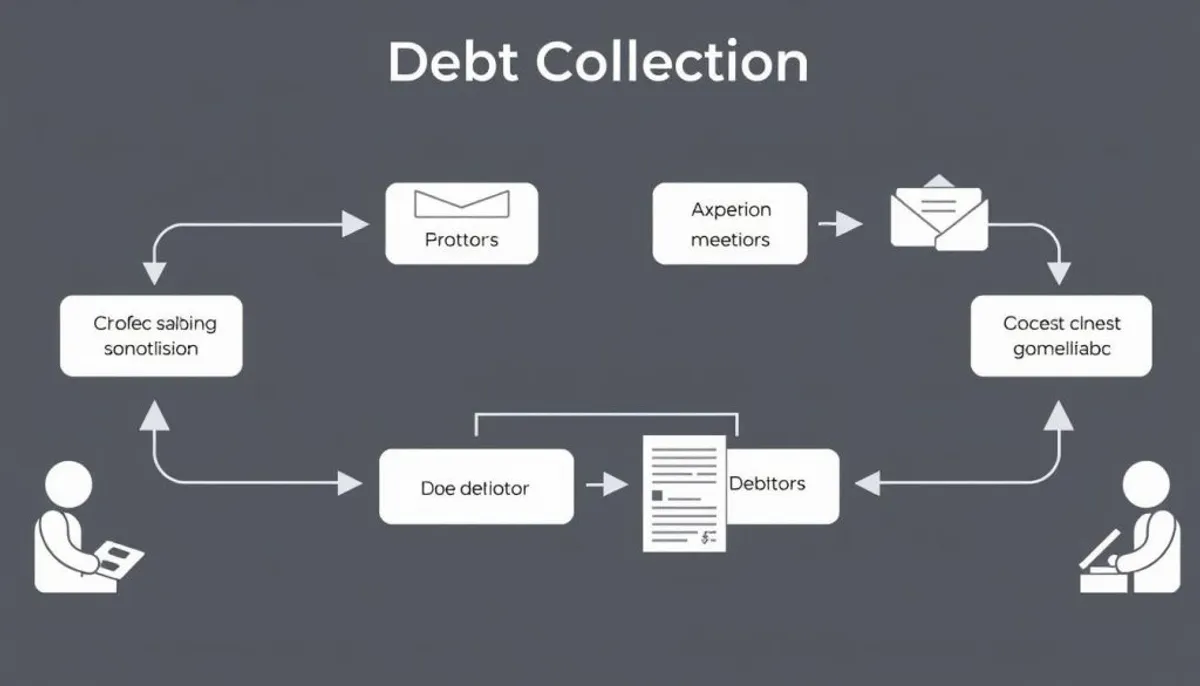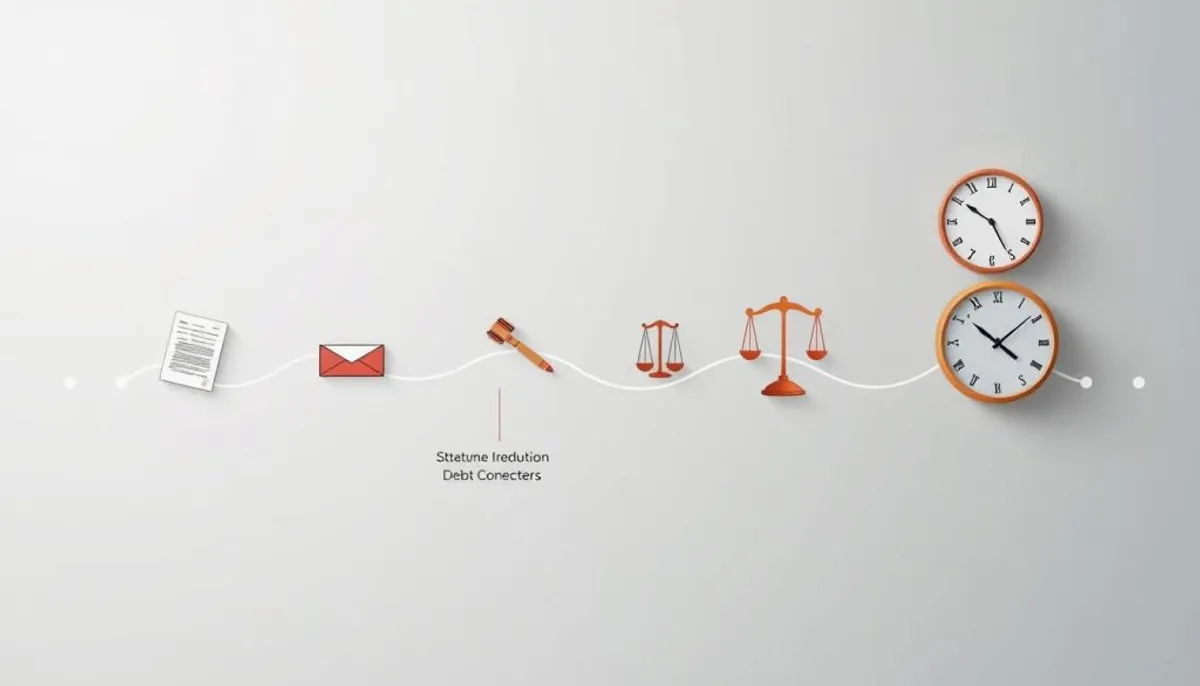When you fall behind on payments, you might encounter debt collection agencies or third-party debt collectors. But did you know there’s another player in this field? Enter debt buyers. These companies purchase past-due accounts from original creditors, often for pennies on the dollar.
Understanding the difference between debt buyers and collectors is crucial if you’re facing financial difficulties. While both aim to recover unpaid debts, their methods and motivations can vary significantly.

Debt buyers typically acquire portfolios of delinquent accounts, hoping to turn a profit by collecting more than they paid. On the other hand, third-party debt collectors work on behalf of lenders or debt buyers, earning a commission on what they recover.
The timeline for debt transfer depends on various factors, including state regulations and the type of debt. Knowing your rights and the rules governing these entities can help you navigate the complex world of debt collection more effectively.
Key Takeaways
- Debt buyers purchase delinquent accounts, while collectors work for creditors
- Buyers often pay cents on the dollar for old debts
- The Fair Debt Collection Practices Act protects consumers
- Debt transfer timelines vary by state and debt type
- Understanding these differences is crucial for managing debt effectively
Understanding the Debt Collection Landscape
The debt collection industry is a vital component of the financial system. It encompasses a multitude of entities, from the original creditors to debt purchasing companies. This intricate network has undergone substantial transformations, notably with the advent of consumer debt litigation.
Role of Original Creditors
Original creditors are the entities that extend loans or credit to borrowers initially. When borrowers fail to make payments, these creditors often transfer the unpaid debts to specialized entities. This action aids in reducing liabilities and recovering losses.
Why Companies Transfer Unpaid Debts
Debt sale provides immediate liquidity, which can be beneficial during financial challenges. It enables creditors to concentrate on their core activities while specialized firms manage collections. In 2014, the Office of the Comptroller of the Currency introduced stricter guidelines on debt sales. These guidelines underscore the importance of responsible practices.
Timeline of Debt Transfer Process
The duration of the debt transfer process varies, influenced by creditor policies and state regulations. It typically commences after a period of non-payment, spanning from a few months to several years. In 2024, New York shortened the statute of limitations for debt collectors from six to three years, affecting this timeframe.
| Aspect | Debt Sale | Debt Collection |
|---|---|---|
| Revenue Stream | Immediate liquidity | Ongoing collection efforts |
| Strategy Focus | Blending purchasing and collections | Specialized collection techniques |
| Partner Selection | Debt buyers with digital strategies | Collection agencies with varied approaches |
| Compliance | Regular audits of buyers | Adherence to collection laws |
Debt Buyer vs Collection: Essential Distinctions
The debt collection industry is comprised of two pivotal entities: debt buyers and collectors. Each entity plays a distinct role in the recovery of unpaid debts. Grasping their differences is essential for individuals facing financial obligations.
Debt buyers engage in the acquisition of debt portfolios, purchasing debts from original creditors. They become the proprietors of these debts, often at a fraction of the original value. This practice is prevalent for debts with longer histories. Debt buyers may either collect debts themselves or subcontract this task to third-party collectors.
Conversely, debt collectors act as agents for creditors or debt buyers. They do not possess the debts they pursue. Instead, they are remunerated based on the amounts they successfully collect. This compensation structure motivates their collection endeavors.
Both debt buyers and collectors are bound by the Fair Debt Collection Practices Act (FDCPA). This federal legislation establishes standards for debt collection, safeguarding consumers from exploitative practices. In California, the Debt Collection Licensing Act commenced in 2022, mandating licensure for all debt collectors.
| Aspect | Debt Buyers | Debt Collectors |
|---|---|---|
| Ownership of Debt | Own the debt | Do not own the debt |
| Profit Model | Full amount collected | Commission on amount collected |
| Initial Investment | Purchase debt portfolios | No upfront investment |
| Collection Method | Self-collect or hire third-party | Collect on behalf of others |
It is imperative for consumers to be cognizant of their rights under the FDCPA. For example, debt collectors must furnish a validation notice within five days of initial contact, specifying the debt amount and creditor’s name. In California, consumers possess the right to sue debt collectors for infractions of state and federal collection laws.
How Debt Buyers Operate in the Industry
Debt buyers are pivotal in the debt collection sector. They acquire portfolios of delinquent accounts from creditors at significantly reduced rates. Often, they pay mere cents for each dollar of the debt’s face value.
Debt Portfolio Acquisition Process
Debt buyers aim to accumulate large volumes of unpaid debts to enhance their profit margins. They typically invest $50 for every $1,000 debt, seeking to realize a $950 profit if the debt is fully repaid. This strategy enables original creditors to recoup some funds while transferring the collection burden.
Profit Models and Pricing Structure
The pricing for debt portfolios is determined by the debt’s age and type. Older debts are less expensive due to their lower collectibility. Debt buyers can purchase hundreds of delinquent accounts, boosting their profit potential. Their business model hinges on collecting more than the initial purchase price of the debt portfolio.
Legal Requirements for Debt Buyers
Debt buyers must adhere to federal and state laws in their collection practices. They are subject to the Fair Debt Collection Practices Act, which safeguards consumers from unfair collection methods. Various states impose statutes of limitations on debt collection efforts, ranging from three to six years. Debt buyers can initiate legal action against individuals who fail to settle their debts before this timeframe lapses.
Grasping the operations of debt buyers is essential for differentiating between debt buyer and collection agency practices within the debt collection industry.
Third-Party Debt Collectors: Roles and Responsibilities
Third-party debt collectors are pivotal in the financial sector. They act as intermediaries for creditors or debt buyers, aiming to recover unpaid debts. Employing diverse strategies, such as letters and phone calls, their primary objective is to collect outstanding payments within the bounds of strict regulations.
These professionals are bound by stringent guidelines regarding consumer communication. They are prohibited from engaging in collection harassment or employing unfair tactics. For instance, they cannot initiate calls at inopportune hours or employ intimidating language. It is also imperative for collectors to honor a debtor’s right to debt validation.
Upon being contacted by a collector regarding a debt, consumers possess the right to demand verification of the obligation. This process, known as debt validation, serves as a safeguard against errors and fraudulent activities. If validation is requested, the collector must furnish concrete evidence of the debt before proceeding with collection efforts.
It is noteworthy that debt collectors can significantly influence one’s credit score. They may report unpaid debts to credit bureaus, potentially lowering creditworthiness. Yet, collectors are precluded from seizing funds from a debtor’s paycheck without a court mandate. They must adhere to legal protocols and uphold consumer rights throughout the collection process.
| Debt Collector Responsibilities | Consumer Rights |
|---|---|
| Follow communication rules | Request debt validation |
| Provide proof of debt | Dispute inaccurate debts |
| Report to credit bureaus | Protection from harassment |
Legal Framework and Consumer Protection
The legal framework governing debt collection is intricate, with both federal and state laws safeguarding consumers from exploitative practices. It is imperative for collectors and debtors alike to grasp these regulations within the context of consumer debt litigation.
Fair Debt Collection Practices Act Overview
The Fair Debt Collection Practices Act (FDCPA) establishes a nationwide benchmark for debt collection practices. Its primary objective is to curb abusive methods that could precipitate personal bankruptcies and employment loss. The FDCPA delineates debt collectors as entities or individuals engaged in the collection of debts owed to third parties.
Consumer Rights Under FDCPA
Under the FDCPA, consumers are endowed with substantial rights. Debt collectors are prohibited from initiating contact at inconvenient hours, such as before 8 am or after 9 pm. They must clearly identify themselves when seeking to obtain a debtor’s location. The Act further restricts communication with third parties regarding a debt without the consumer’s explicit consent.
State-Specific Regulations
States often augment federal protections with their own measures. For instance, some states mandate debt collectors to hold a license. In one jurisdiction, the cost for a debt collector license is $350, with an additional $150 investigation fee per applicant. The timeframe for processing license applications typically spans approximately 90 days.
| Regulation | Details |
|---|---|
| Debt Collector License Fee | $350 |
| Investigation Fee | $150 per applicant |
| License Review Period | Approximately 90 days |
| Annual Report Submission | Jan 1 – Mar 15, 2025 |
Debt validation stands as a pivotal right under these statutes. Consumers can demand verification of the debt, ensuring they are not obligated to pay for inaccuracies or fraudulent claims. This right is fundamental in consumer debt litigation, safeguarding individuals against unjust collection practices.
Impact on Consumer Credit Scores
Credit reporting is pivotal in shaping consumer credit scores. Debt buyers and collection agencies can report purchased debts to credit bureaus, impacting your financial standing. This process influences your credit history and score over time.
Credit Reporting by Debt Buyers
Debt buyers wield significant power in reporting acquired debts to credit bureaus. This action can substantially affect your credit score. Recent statistics reveal a decline in collections tradelines on credit reports, from 261 million in 2018 to 175 million in 2022. This 33% decrease has resulted in a 20% reduction in consumers with collection tradelines on their credit reports.
Collection Accounts and Credit History
Collection accounts can remain on your credit report for up to seven years from the date of first delinquency. Medical bills constitute a significant portion of collections, accounting for 57% of all collection items. While paying off a collection account does not remove it from your credit report, it may update the status to “paid” or “settled.” This update could potentially lessen its negative impact.

Timeline for Credit Impact
The impact of collection accounts on your credit score varies with the credit scoring model used. Newer models may treat certain collections less harshly or even disregard smaller accounts. Regular payments to debt buyers can gradually improve your credit score over time, provided you meet other credit obligations.
| Credit Impact Factor | Duration | Effect on Credit Score |
|---|---|---|
| Collection Account Reporting | Up to 7 years | Negative |
| Paid Collection Status | Immediate update | Potentially less negative |
| Regular Payments to Debt Buyers | Ongoing | Gradual improvement |
ti3 Platform: Modern Solution for Debt Management
The ti3 platform represents a groundbreaking SaaS platform, aimed at transforming debt management. It introduces a sophisticated suite of tools, designed to streamline collection processes and fortify client relationships.
Automated Payment Reminders
ti3’s automated payment reminder system is a paradigm shift. It dramatically reduces invoice processing costs, from an average of $12 per invoice to a mere fraction. This innovation slashes processing time by 80% and minimizes errors by 66%, ensuring prompt payments and enhanced cash flow.
Streamlined Collection Process
The platform’s streamlined collection process directly addresses late payment issues. Given that 44% of mid-sized companies face delayed invoices monthly, ti3 aids in reducing the $909,506 lost each month due to such delays. Its electronic invoicing system significantly reduces payment times compared to traditional paper-based methods.
Client Relationship Management
ti3 stands out in maintaining positive client relationships while efficiently managing debt. Its clear communication features enhance the likelihood of on-time payments by 8 times. This strategy helps mitigate the adverse effects of late payments, which impact 90% of businesses.
By adopting ti3’s SaaS platform, businesses can substantially enhance their debt management processes, lower costs, and preserve robust client relationships. This debt management software presents a cost-effective alternative to conventional collection methods, empowering businesses to manage their financial health effectively.
Debt Validation and Consumer Rights
Debt verification is a cornerstone of consumer protection within the debt collection framework. The Fair Debt Collection Practices Act (FDCPA) affords consumers the right to demand validation of any debt claimed against them. This validation process is essential, ensuring that debt buyers and collectors substantiate the debt’s legitimacy and their entitlement to collect it.
Upon initial contact, debt collectors must furnish specific details within a five-day timeframe. These details include their name, address, the original creditor’s name, and a detailed breakdown of the debt amount. Consumers then have a 30-day window to request debt validation.
Upon a request for validation, debt collectors must suspend all collection activities until they furnish proof. This proof may encompass original agreements or statements detailing the debt amount. If they fail to verify the debt, they are prohibited from continuing collection efforts or reporting the debt to credit bureaus.
| Consumer Rights | Debt Collector Obligations |
|---|---|
| Request debt validation | Provide proof of debt |
| Dispute inaccurate information | Cease collection until verification |
| Limit communication methods | Respect communication preferences |
| Sue for FDCPA violations | Adhere to FDCPA guidelines |
Grasping these rights is pivotal in safeguarding against the payment of invalid debts and fraudulent collection schemes. Always assert your right to debt verification when confronted with debt collectors or buyers.
Statute of Limitations on Debt Collection
The timeline for debt collection is pivotal in managing unpaid debts. Grasping the statute of limitations is essential for consumers to navigate legal actions and safeguard their rights.
Time Limits by Debt Type
Debts vary in their legal action timeframes. Credit card debt statutes span from 3 to 10 years, contingent on the state. Written contracts and promissory notes generally have longer statutes.
| Debt Type | Typical Statute Range |
|---|---|
| Credit Card | 3-10 years |
| Written Contracts | 4-6 years |
| Oral Agreements | 2-6 years |
| Court Judgments | 3-21 years |
State Variations in Limitations
Statute of limitations differs significantly by state. For instance, Massachusetts, Connecticut, Maine, and Vermont have a 6-year statute for credit card debt. Court judgment limitations range from 3 years in Oklahoma to 21 years in Ohio.

Actions That Reset the Clock
Consumers must be vigilant about actions that can restart the statute of limitations. Making a payment or acknowledging the debt in writing can reset the clock, potentially extending the debt collection timeline. It’s crucial to note that while collectors can’t sue after the statute expires, they may still attempt to collect the debt.
The statute of limitations doesn’t influence how long a debt stays on your credit report. Delinquent debt remains for 7 years, regardless of legal time limits.
Conclusion
Grasping the differences between debt buyers and collectors is crucial for effective debt management strategies. The debt collection landscape has evolved, influenced by legal precedents. For example, the Supreme Court’s decision in Henson v. Santander Consumer USA Inc. established that debt buyers are not always bound by the Fair Debt Collection Practices Act (FDCPA).
The financial planning implications are profound. With one in seven U.S. adults facing debt collection, averaging $1,500 per case, the necessity for informed financial decisions is evident. Credit card debt is the dominant force in the debt-buying market, making up 65% of purchased debts’ face value. This highlights the critical role of responsible credit use in personal financial planning.
Modern solutions, such as the ti3 platform, provide businesses with tools for efficient debt management while preserving client relationships. As the debt collection industry continues to expand, with revenue increasing 6.5 times from 1972 to 2010, consumers must remain informed about their rights and options. By understanding the debt collection process and leveraging available resources, individuals can better navigate financial challenges and strive towards long-term financial stability.
RelatedRelated articles



